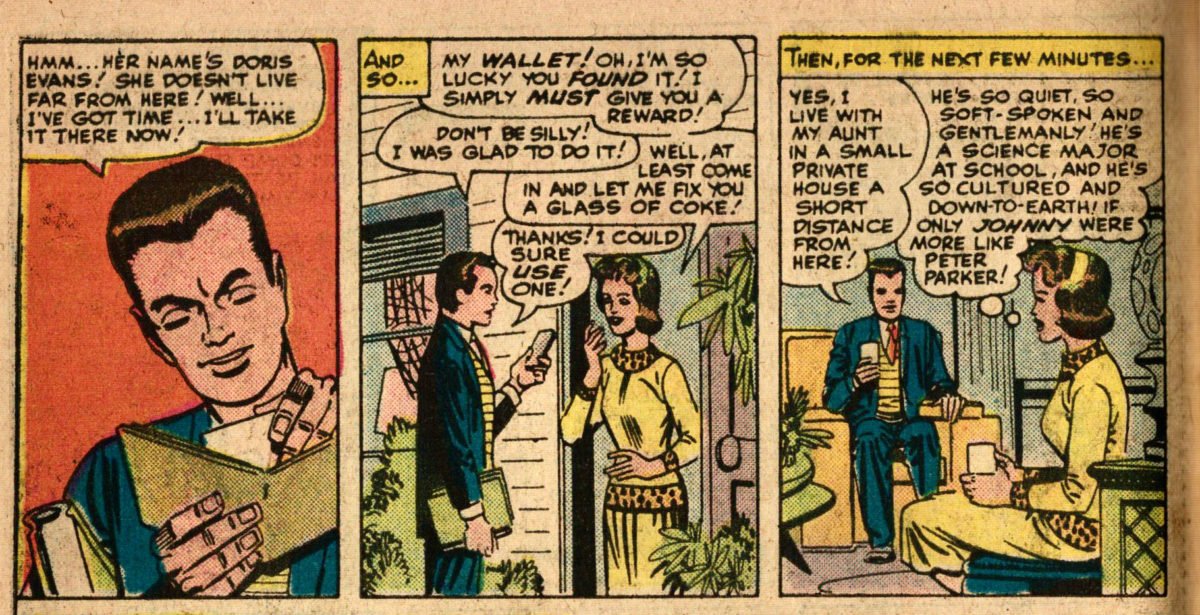Featuring: Nick Fury, Agent of SHIELD
Release: May 4, 1965
Cover: August 1965
12 cents
Writer: Stan Lee
Artist: Jack Kirby
Inked by: Dick Ayers
Lettered by: Artie Simek
12 pages
| Previous | #369 | Next |
|---|---|---|
| Amazing Spider-Man #27 | Reading order | Sgt. Fury #20 |
| Strange Tales #134, Story B | Strange Tales | Strange Tales #135, Story B |
Your entire life qualifies you for this job!
It’s 1965. Thunderball will be hitting the cinemas in Decembr, the 4th consecutive year Sean Connery will go into action as 007.
In the second film, From Russia with Love, we were introduced to a global criminal organization that it takes a dedicated government to fight– SPECTRE (Special Executive for Counter-intelligence, Terrorism, Revenge, and Extortion).
The head of SPECTRE wasn’t named and we didn’t see his face, only his kitten. The kitten plainly identifies him as evil.

These movies are popular, and the rest of the entertainment industry is taking notice.
Michael Caine just went into “action” in a more subdued and bureaucratic spy tale as Harry Palmer, definitely not the world’s best spy.
Television will soon be satirizing this secret agent genre with Get Smart, in which Maxwell Smart of CONTROL fights against KAOS, an international organization of evil.
The following year, secret agents on TV will be offered an impossible mission, if they choose to accept it.
Probably most relevantly, the previous year introduced The Man from UNCLE (United Network Command for Law and Enforcement), letting us know that these organizations should have acronyms for names.

In the 1950s, Marvel had dabbled in every genre, including the occasional spy series like Spy Fighters or Kent Blake of the Secret Service.


Now they are bursting at the seams with the expanding superhero genre. They have one current war title, Sgt. Fury, which we’ve been reading with the superhero comics for some reason.
They haven’t abandoned their long successful romance/humor girl genre, and Millie and Patsy each carry two titles still. And three western heroes still carry titles: Two-Gun Kid, Rawhide Kid, and Kid Colt.
They’re ready to ride on the booming spy genre with their own 007 or Man from Uncle. They’ll need a secret spy organization with a cool title that’s really an acronym. And they’ll need an evil organization to pit them against. Preferably headed by a mysterious man with a kitten.
And a star to headline these adventures. New character? Or look to their already expansive cast of characters.
We know from the pages of Fantastic Four that Sgt. Fury of World War II is now Colonel Fury of the CIA. Why invent a new top spy when you already have one?
Where to put them? Make a new title? No, you’re having crazy distribution problems at the moment and are artificially limited in the number of titles you can put out. Why Captain America and Iron Man need to share a book.
I’ve got it! Strange Tales. The Human Torch/Thing stories all sucked, so we cancelled them. Our new spy series can share this former horror title with Dr. Strange. Makes sense to me.
On that note, I then have to recall that we haven’t actually read any Dr. Strange stories since issue 129, 6 issues ago. We read the wonderful Human Torch stories from issues 130-134, but skipped the Dr. Strange stories.
But now that Nick Fury is taking over the first half of the book, I would like to… still not read the Dr. Strange stories. Not just yet. We’ll read this first half of this comic, then return to it later. Even though, with the new Dr. Strange movie out, a Dr. Strange post would be topical.
Continue reading “Strange Tales #135”









































